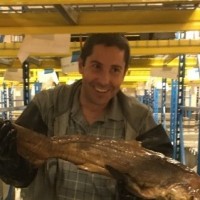Dr. Samantha Price - Associate Professor
|
I am particularly interested in the evolutionary dynamics of ecological shifts, such as changes in habitat or diet, their relationship to environmental change and their impact on subsequent ecomorphological and lineage diversification. I specialize in generating large ecological and morphological datasets and analysing them using phylogenetic comparative methods in a high performance (HPC) framework. My aim is to identify repeating themes and general principles governing the evolution of vertebrate biodiversity. My full CV, undergraduate and graduate teaching and other activities are accessible from my Personal page.
|
Dr. Jennifer Hodge - Postdoctoral researcher
|
Jennifer Hodge joined the Price lab as a post-doc in January 2020. Jennifer received her Ph.D. in Marine Biology from James Cook University in Australia, where she studied biogeography and the evolution of coral reef fish species. Her research seeks to understand the processes that shape the distribution of life. She takes a macroevolutionary approach to investigate the dynamics of biodiversity across large taxonomic, spatial and temporal scales. Past projects have explored how ecological interactions, the environment and evolutionary history have influenced the diversification of fishes. At Clemson, she is investigating the impacts of evolutionary history on patterns of ecomorphological convergence. She also plans to examine the interplay of evolutionary and ecological processes in generating diversity within communities and across spatial scales.
|
Mason Thurman - Ph.D. candidate
|
An ecomorphological approach to eye evolution across anatomical levels in teleost fishes
My work investigates how ecological factors influence the macroevolution of the teleost eye both within and between three anatomical levels of the fish visual system, taking into account the impact of evolutionary history, fish size, and physical constraints. I aim to uncover how their eyes have enabled them to adapt and diversify to a wide range of environments. |
Marina Carbi - Ph.D. student
|
Macroevolution of the teleost lateral line
I am interested in the diversity of patterns found in the trunk lateral line canal of teleost fishes. My research investigates the evolution of distinct canal patterns and explores the potential influence of ecology and body shape within a phylogenetic context to identify convergence. |
Alumni
Dr. Danielle Adams - Ph.D. summer 2025 currently a postdoc at The Field Museum with Dr. Stephanie Smith
|
Co-advised with Dr. Rick Blob. I am interested in investigating the functional morphology of the cetacean skull as well as cetacean trophic morphology from a comparative and biomechanical prospective. I am interested in the two main functions of the odontocete skull, feeding and echolocation, and any trade-off that may exist in the functional morphology and material properties of the bone. The other aspect of my dissertation is focused on the evolution of control surface morphology across the cetacean phylogeny and the hydrodynamic implications for cetacean foraging strategies.
|
Dr. Keiffer Williams - Ph.D. summer 2025 currently a 3-year visiting assistant professor at La Brea College in Kentucky
|
I am broadly interested in the evolutionary patterns and processes that influence trophic morphology in ray-finned fishes. In particular, I’m interested in the drivers of morphological and mechanical evolution in the jaws and teeth of detritivorous marine fishes. Many marine detritivores exhibit an elongate tooth morphology that is used to “scrape” substrate for food acquisition, although relatively little is known about the effects of detritivory on phenotype diversification. Much of my fascination with fish trophic morphology derives from my MS research, which focused on the morphology and evolution of tooth replacement in combtooth blennies (family: Blenniidae). I will use my time as a PhD student in the Price lab to develop my skills in using phylogenetic comparative methods to understand fish trophic morphology evolution at a macro-scale.
|
Katerina Zapfe - MS spring 2021 currently a Ph.D. student at UNC Charlotte with Dr. Alex Dornburg
|
Kat was a NSF Graduate Research Fellow who graduated with a MS degree in August 2021 on the "Macroevolution of Bold Color Patterns Across Teleostean Fishes" and interested in the evolution of fish phenotypic diversity.
|
Dr. Laura Alencar - Postdoctoral researcher 2019-2021
|
Dr. Alencar is now a postdoctoral researcher at Yale University with Dr. Martha Muñoz.
I am primarily interested in understanding the patterns and processes shaping the radiation of vertebrates. My research combines natural history, morphological, geographical and phylogenetic information with the application of statistical models to answer questions in large taxonomic, temporal and spatial contexts. I have been mostly working with squamate reptiles exploring the drivers underlying species and morphological diversification as well as the drivers of species coexistence. In the Price Lab, I am investigating temporal and spatial changes in morphospace occupation across the global radiation of teleost fishes. |
Dr. Olivier Larouche - Postdoctoral researcher 2018-2020
|
Dr. Larouche is now an Assistant Professor at Western Carolina University
I am broadly interested in the interrelationships between organismal properties and ecological factors that promote the diversification of animal form. I completed my Ph.D. in biology at the Université du Québec à Rimouski (Quebec, Canada) under the co-supervision of Dr. Richard Cloutier and Dr. Miriam L. Zelditch (University of Michigan). My doctoral thesis focused on the relationships between modularity, morphological disparity and evolutionary rates using fishes and their appendages as a model system. I am now investigating ecological correlates of body shape evolution in ray-finned fishes. |
Benjamin Camper - Undergraduate Honors Student now Bewick lab tech
|
I am broadly interested in studying community ecology, macroecology, macroevolution, and herpetology. My time as an undergraduate has been spent assessing the community composition of herpetological systems across heterogeneous landscapes, the population dynamics of an Appalachian salamander hybrid zone, and the thermal physiology of Eastern fence lizards. I am now conducting my senior thesis in the Price Lab examining the size-latitude relationship of teleost fishes, how body shape characters may influence this relationship, and how evolutionary rates of these morphological characteristics may be influenced by a latitudinal gradient. My time is shared with the Bewick Lab where I work as a lab technician investigating how host-associated microbial communities change across space and time.
|
Creative Inquiry Teams - Undergraduate researchers
|
|
2020-2021 Grace Holliday, Hayley Schopfer, Justin Thomas and Marco Guareschi. These students have been working throughout the pandemic on the evolution of defensive traits in catfishes and looking at the evolution of venom and fin spines. They gave a fantastic SICB+ in 2022 see video to the left
|

2019-2020 left to right. Front row: Saanga Alikhail, Dominique Gross, Nicole Nelligan. Back row: Delaney Freehill, Bailey Benton, Anand Loganathan & Myles Davoll.. Everyone here is involved in the Fish Shapes project and are part of a Creative Inquiry team that were working on the ecological factors that influence the body shape evolution of cichlids. They gave an amazing SICB talk in 2020 (see below) and the paper is being worked on!
|
|

2017-2019 From left to right: Lucas Mccutcheon, Sierra Rodriquez, Carley McGlinn, Dominique Gross, Mia Iwan, Hannah Whelpy, Nick Hix, Bailey Benton & Hannah Wells - undergraduate researchers Not shown Brian Kessler. Everyone here is involved in the Fish Shapes project and are part of a Creative Inquiry team that has worked on the ecological factors that influence the body shape of marine fish, focusing specifically on locomotor performance and we have recently published a paper from this research: Larouche, O., Benton, B., Corn, K.A., Friedman, S.T., Gross, D., Iwan, M., Kessler, B., Martinez, C.M., Rodriguez, S., Whelpley, H. and Wainwright, P.C., 2020. Reef-associated fishes have more maneuverable body shapes at a macroevolutionary scale. Coral Reefs, pp.1-13.
(c) EvoVert: Samantha Price 2019 - sprice6 'at' clemson 'dot' edu









